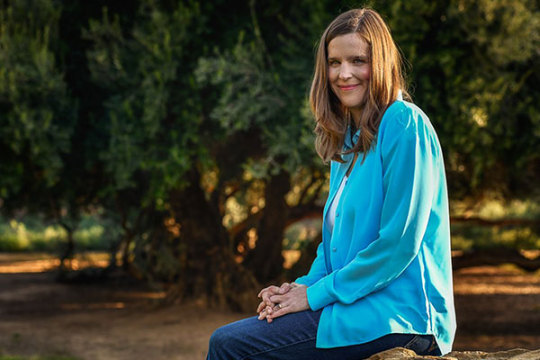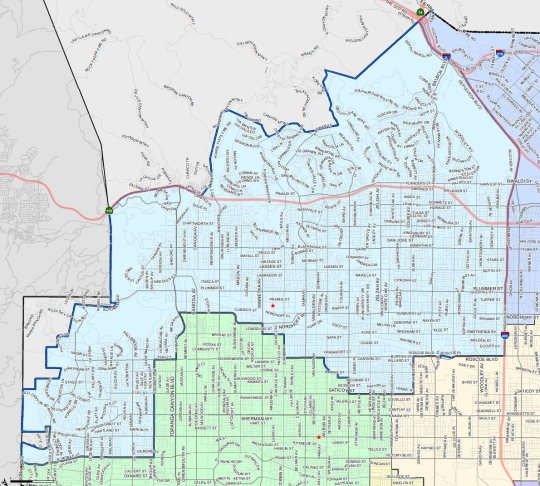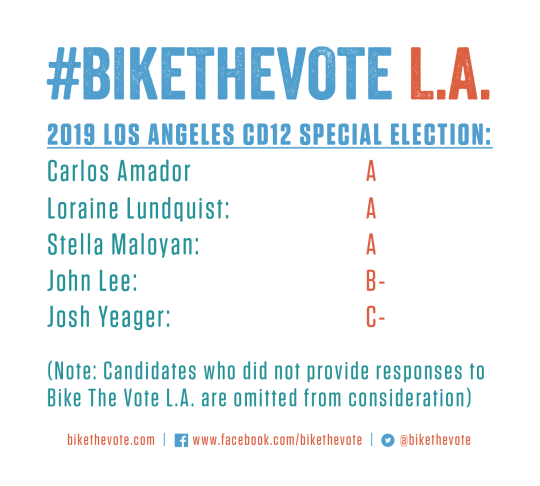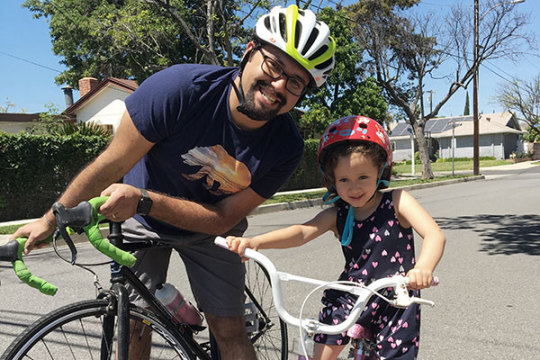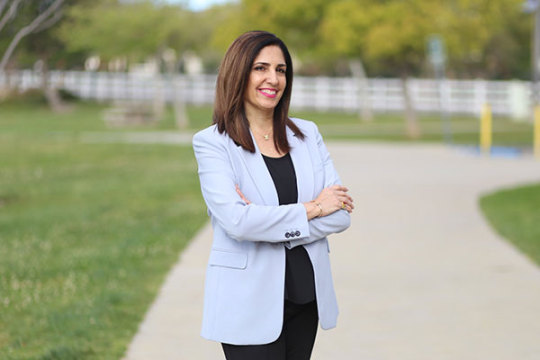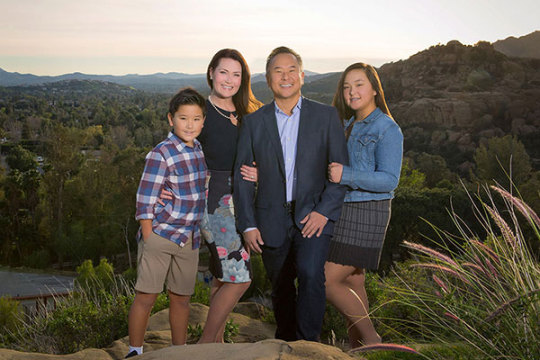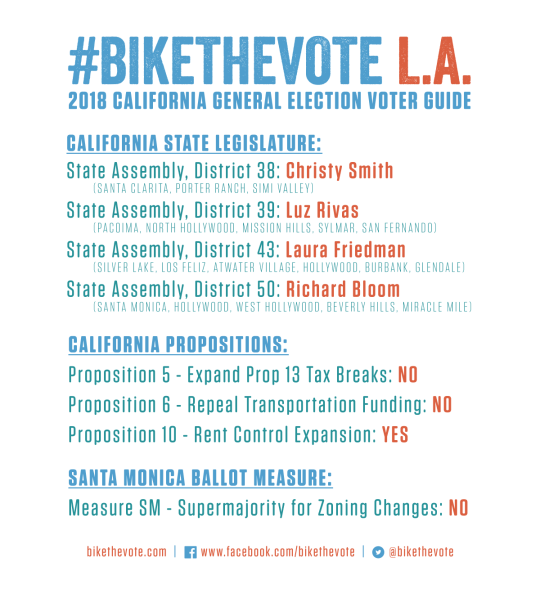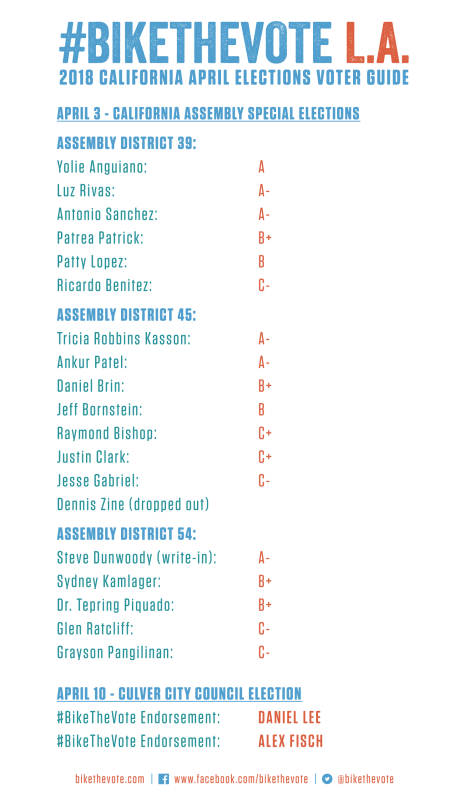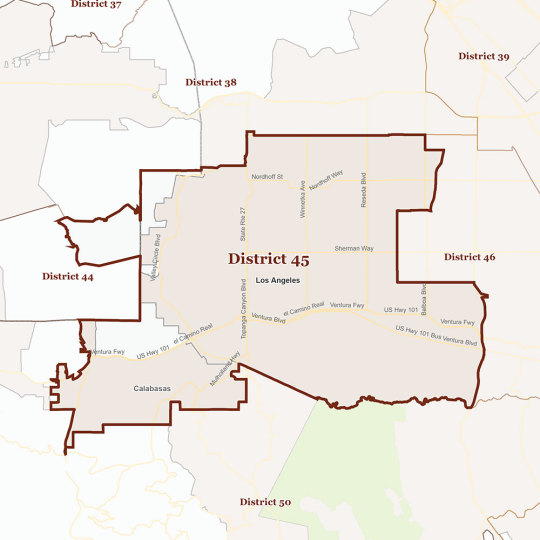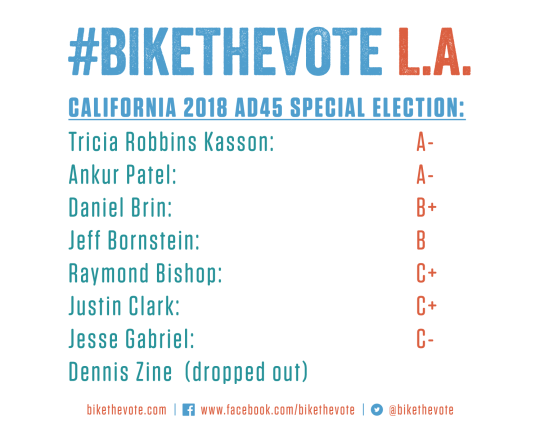Candidate campaign page: https://www.loraineforla.com/
In her response to our questionnaire, Loraine Lundquist impresses with her deep knowledge and detailed platform on transportation. A faculty member at the Institute for Sustainability at Cal State Northridge, Lundquist has clearly done her homework, and it shows in her comprehensive policy prescriptions addressing infrastructure, bus service, carpooling, land use, tree canopy, ADA accessibility, and more. As a member of the Northridge East Neighborhood Council, she has put that understanding of safe streets to work, sponsoring the Mobility Bill of Rights. She’s willing to do what it takes to prioritize safety for people walking and biking, pledging to use data to target the district’s most dangerous intersections and implement needed changes.
Lundquist also emphasizes her personal stake in improving active transportation, citing her own daily bike commute to campus and her family’s reliance on transit to get around their neighborhood. Between her personal choices and her professional focus, Bike The Vote L.A. is confident that improving mobility options across the 12th District will be a high priority for Lundquist as a councilmember, and that she’ll be a valuable ally for safe streets advocates on the L.A. City Council.
Bike The Vote L.A. 2019 Primary Grade: A
(See below for full candidate questionnaire response)
1. What role do you see for walking, transit, and biking in the getting residents and students in Council District 12 to and from local businesses, parks, and schools?
In many ways, I’ve been trying to live my vision for LA transportation. Since we got our big yellow cargo bike about five years ago, my family and I have logged more than 5,000 miles biking around CD12 to go to work, school, the park, the library, the grocery store, the dentist, and all the other places a busy family travels. When going further afield, we take public transit – including local bus lines (167, 236, 166, 158, and more), the Orange Line, MetroLink, and the Commuter Express – as our primary mode of transportation. So when I talk about what works and what doesn’t about CD12 transportation, I know from personal experience.
Transportation affects our quality of life in so many different ways – time, money, air quality, and even the opportunities to interact with one another as we move through our community. While LA has historically been the car capital of the world, we must re-envision both the culture and infrastructure for LA transportation. Specifically, LA’s Sustainability pLAn envisions 50% of all trips originating in LA are made by foot, bike, or transit by 2035 – an ambitious goal which we may nevertheless find insufficient once we get serious about tackling our climate crisis.
Improve multi-modal infrastructure. We have a long way to go. We’ve inherited a transportation infrastructure designed for cars with acres of impervious surfaces devoted to wide roads and parking lots. We need to enhance these corridors for multi-modal transit with dedicated bus lanes, bike lanes, and green spaces that enhance walkability. CD12’s bicycle infrastructure is currently fragmented, and bus service is infrequent on most lines.
Make transit more accessible and more attractive. Our current transportation network does not serve everyone equally. My students at CSUN often cannot afford their own vehicles and spend hours each day riding transit while people with more money can get rapidly from one place to the next in private vehicles or ride hailing. This lost time translates to lost opportunity. Every person deserves the right to move freely around our city regardless of their age or economic means. That’s why I support the Mobility Bill of Rights and introduced a motion that my Neighborhood Council to formally endorse it. As a member of LA City Council, I will advocate that transit within the City and Metro systems be free to all. Increased ridership will decrease congestion and allow us to provide a wider range of transit options (including more routes, more frequent service, and more lines with ‘rapid’ and ‘local’ options to serve people traveling different distances on the same routes).
Make long-term planning decisions that re-think the use of space in our City. LA grows by 20,000-30,000 people each year. That means we need to find housing for a quarter million new people in the next decade (US Census). With relatively few new places to build, increasing density is the reasonable solution. Yet here in CD 12, many people live here, moved here, or stay here because they enjoy the suburban feel. We can maintain this suburban feel for much of the valley while also creating urban nodes within the larger suburban landscape. These urban nodes should be near transit hubs with mixed-use residential and commercial spaces with large sidewalks, trees, bike lanes, and other amenities that make mutli-modal transportation appealing and natural. Increasing density in this form will build community and economic activity, reduce commute times for many, and generally improve quality of life in the valley.
2. Thirty-eight percent of Cal State University, Northridge students do not have access to a car for their daily commute. What actions can Los Angeles take to make the CSUN campus more accessible for students, staff, and faculty including better bike, pedestrian, and transit connectivity around the campus? Additionally, do you support implementation of protected bike lanes on Parthenia Street to connect Metrolink Northridge Station to existing protected bike lanes on Reseda Boulevard?
As a CSUN employee, I commute to campus by bicycle. At CSUN, two important transportation constituencies require different solutions: students living within a few miles of campus and students that commute longer distances. According to a robust CSUN survey, about 60% of CSUN students would be willing to take transit to campus if it were convenient, and convenience is the number one priority for the majority of students due to their busy lives commuting between work, home, and campus.
Enhanced local transportation options for the 35% of CSUN students that live within 5 miles of campus. Thousands of these students remain underserved by our local transit lines that run infrequently and are not timed well to CSUN class schedules. One idea to consider is a local shuttle service that circulates on major arteries in the communities around CSUN. No transit system will be perfect, especially when it comes to the ‘last mile’ – which is why bikes and other wheeled transportation should be an important piece of local transit planning. Our busses need more bike capacity for students to be able to depend upon them.
Enhanced regional transit for the remaining students that commute from long distances. In response to student complaints of parking delays and neighbors frustrated by students parking in surrounding areas, the campus has prioritized building new parking, including the Zelzah/Plummer parking structure. The campus made this $26 million investment in car culture and we look forward to comparable capital investments to accommodate bus rapid transit station(s) and eventual rail line expected in coming years through measure M dollars. It’s important these travel next to CSUN with a stop at CSUN.
Carpooling. The campus has attempted to link its class registration system to a carpool planning web application, but the system is under-utilized. I support CSUN offering greater incentives for carpooling such as preferred parking or financial payouts. Compared to the cost of parking and transit infrastructure, these incentives could be cost-effective.
Metrolink connectivity. Only about 2% of CSUN students commute by Metrolink. We clearly need a better interconnected network of bike routes. Allowing a smooth ride from Metrolink to CSUN requires additional interconnectivity. I support a community dialog among riders, planners, and community members to determine the optimal way to accomplish this connectivity. Ideas include connecting a pedestrian bridge to Vanalden Park along with improved bicycle infrastructure through the residential communities along Vanalden and Prairie, moving the entire Metrolink station east to Reseda, or establishing a protected bike lanes along the industrial/commercial corridor of Parthenia.
3. CD12 sees some of L.A.’s worst speeding and street racing, with three out of the top five most dangerous intersections in all of California located within the District. In response to the condition of dangerous streets across the city, Los Angeles adopted a ‘Vision Zero’ program with the goal of significantly reducing the 240+ annual roadway deaths that the City currently sees. Do you support prioritizing safety on L.A.’s High Injury Network streets in CD12 such as Reseda, Roscoe, and Balboa Boulevards, even when there may be trade-offs in terms of automotive travel time or on-street parking?
One of the recent fatal street racing crashes occurred two blocks from my house and the community still decorates the location of the crash for every holiday – even two years later. I’ve witnessed half a dozen non-injury accidents at the same intersection over the last few years, and this is not even one of the top five most dangerous.
I support safety improvements such as the ones implemented by Vision Zero. As a CSUN faculty member, I advised a group of my students who came up with a specific plan for improving the intersection of Reseda and Devonshire. They presented to the local neighborhood council and canvassed the area to assess local support for the ideas, which was high. A local news network interviewed one of my students (and myself) about the intersection and their proposal. Drawing attention to the problem is a first step, but I plan to implement designs like theirs at intersections in our district that badly need them.
Vision Zero has implemented a number of safety improvements to city streets, but only about five of them are within CD12 (and two of those are not even on High Injury Network streets). I will ensure that CD12 gets its fair share of these important resources and they are targeted to the sections of street that need them most. We have data that show us which intersections these are, but we do not seem to be targeting them effectively.
Going further, I recently presented a plan to the Los Angeles Police Department for creating a mobility task force made up of LAPD leadership and community members that would elevate help elevate traffic violence to the level of attention it deserves to protect public safety. While our neighborhood councils, neighborhood watch meetings, and Senior Lead Officer reports routinely include reports of car break-ins and burglaries, they often do not include detailed reports on the traffic violence that claims so many lives in our communities. As councilmember, I will work with public safety groups and our police force can bring greater attention to both the problems and solutions to these deaths and injuries.
4. LADOT has determined that speed is the predominant factor in whether traffic collisions are deadly. Despite this fact, Los Angeles recently increased speed limits on 100 miles of local streets to abide by state law, including raising the speed limit to 45 mph on Winnetka Ave., Wilbur Ave. & Reseda Blvd. in CD12. Would you support implementation of lane reductions and other traffic calming infrastructure in order to reduce vehicle speeds on surface streets in CD12?
The data are clear that traffic calming measures reduce crashes. And the effect is not small: 19-42% according to the US Department of Transportation. While increased safety is important, I am also excited about the opportunities that these changes present our communities. While lane reductions are commonly called ‘road diets’, they can be more accurately thought of as ‘road buffets’ because of the increased options of a space devoted to a broader range of transportation options that make walking, biking, and public transit. I also support robust and continued input from the community via neighborhood councils and other interest groups before, during, and after implementation of road buffets to ensure they are meeting community needs.
5. Los Angeles’ traffic woes are compounded by the reality that many parents, students, and workers don’t feel safe commuting even short distances or performing school drop-offs walking, rolling, or by bike. What would you do as Councilmember to improve active transportation options around schools, public transit, and in commercial districts to provide better mobility options for CD12 residents?
Children should be able to walk or bike to school. There are both safety and cultural issues that spur some people to prefer driving over walking.
Pedestrian fatalities have steadily dropped over the decades despite the fact that vehicle miles traveled have skyrocketed. Unfortunately, this trend recently began to reverse and fatalities seem to be going up over the last decade. One part of this growth could be that cell phone technology distracts drivers and pedestrians. Society is still grappling with how to deal with distracted driving. Both technology and education are evolving, and our city needs to invest more in education and outreach about safe driving, walking, and biking practices as part of its efforts to transform transportation.
To encourage more children to walk or ride to school, I propose that more schools organize ‘walking school buses.’ Groups of children traveling together are much more visible and therefore safer than individual children. Intersections with high traffic flow near schools should have higher visibility crossing systems, longer crossing times, and (in some cases) raised crosswalks or pedestrian islands.
While safety is a big part of the active transportation equation, comfort is another piece. Our city-wide efforts to address urban heat island effects have payoff for active transportation as well. Tree cover makes walking more comfortable, yet CD12 lost 15% of its tree canopy in the first decade of the 21st century. In the process of making the city’s sidewalks more ADA accessible (and therefore ‘walkable’), the city has been unnecessarily removing some trees that whose roots have disrupted sidewalks. Without trees, the sidewalks are no longer inviting places to walk. While the ADA accessibility is an essential priority and required by law, other cities have found tree management strategies that preserve valuable large trees and access. Meanwhile, our city does not currently have an urban forestry plan that guides a long term strategy for rebuilding our tree canopy and maintaining our sidewalks, and I will initiate this process. Our plan must include a plan to reduce the inequality in tree canopy where the poorest neighborhoods have the least tree cover.
6. While one of Los Angeles most recently developed districts, CD12 also has the largest senior population by percentage in the city. What improvements to mobility options would you implement to empower CD12’s senior population to comfortably age in place?
The fastest growing group of homeless people is seniors. With fixed incomes, they are among the first to be squeezed out of today’s housing market. Any solution to senior’s mobility must begin with affordable housing. And as we construct more affordable housing units, they need to be part of a master plan of mixed uses where residential and commercial spaces intermix near transit hubs. The vast majority of CD12 neighborhoods require extensive transportation and/or walking to travel from home to retail. While improved bus frequency can help, it will always require wait times and first/last mile walking/transport. Improved solutions for seniors for these first/last mile options will be key.
